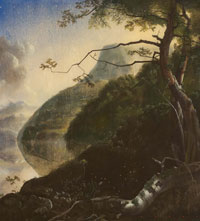 So an artist found a work on the web, copied it and won an award. Why the fuss?
So an artist found a work on the web, copied it and won an award. Why the fuss?
Germaine Greer guardian.co.uk, Sunday 25 April 2010 22.15 BST
Scandal ... Sam Leach's Proposal for a Landscaped Cosmos
Australia is in the grip of another art scandal. This year's Wynne prize of A$25,000 (£15,000) for "the best landscape painting of Australian scenery in oils or watercolours" has been awarded to Proposal for a Landscaped Cosmos by Sam Leach. Leach has freely confessed that his painting is derived from Adam Pynacker's Boatmen Moored on the Shore of a Lake, painted c1660, and now in the Rijksmuseum in Amsterdam. Leach has never seen the original; he found the picture online. Shock and horror were freely expressed: the Australian public is loudly sceptical about what most people continue to call "modern art", given to asserting that their three-year-old could do better, and that it's all a con – much as you would expect to hear in Britain.
Leach won the prestigious Archibald prize this year as well, for a full-length likeness of comedian Tim Minchin. Minchin had wanted to be portrayed on a neon Perspex cross, but Leach objected that this was not his style, which turned out to be the dreariest kind of photorealism. There was no fuss about this unadventurous decision of the judges, who are the director and trustees of the Art Gallery of New South Wales, plus a couple of painters, perhaps because all the other submissions for the portrait prize were dismal.

Boatmen Moored On the Shore of a Lake, c1660, by Adam Pynacker Though Leach's painting was loudly denounced as a "dead ringer" for Pynacker's, it isn't. It's a reduction of a challenging and odd composition to something more challenging and rather odder. Pynacker's is a study in sunset light that flows into the composition from the right. A lake glassily reflects the ebbing light from the sky. In the middle foreground, a single faint shaft illuminates five boatmen, a woman and child, two laden boats, an ass and an ox. Leach removed them all. The void that remained he filled with vaguely star-spangled gloom. He also thinned out the herbage in Pynacker's immediate foreground. Given the smaller format he was using, he could hardly have fitted it in.
The oddest thing not to have changed is the leaves on the tree that frames the right hand side of the composition. Though Pynacker's tree has oaklike leaves, its sinuous trunk is not that of an oak of any kind. It could easily have become a eucalyptus, and Bob would have been Leach's uncle. As it is, the Sydney art pundits are moaning that the scene is not Australian, and that the terms of the prize have been flouted.
Sydney art dealer Martin Browne has weighed in with a suggestion that the prize be rejudged and awarded instead to Tasmanian painter Philip Wolfhagen, whose Journey to the Source V was listed as "highly recommended". What can be identified in Wolfhagen's painting is another battered tree on the right (in this case an Australian blackwood), framing a vaguely threatening distant prospect and a fading sky. If Leach has appropriated Pynacker, he might be considered to have appropriated Wolfhagen, the more successful and better painter, as well. (Wolfhagen won the Wynne prize for a similar work in 2007.) Wolfhagen uses beeswax as a medium for his oil; Leach tries for a similar effect with resin.
Painters do not have to know what they are doing, much less talk about it, but galleristas insist on text to accompany any picture. Leach is quoted as saying: "This work draws on 17th [century] Dutch landscape paintings and the tradition of baroque landscape painting, especially the way they created very idealised constructed landscapes. Historically, those paintings went on to inspire landscape gardeners to try to realise those idealised forms. I looked at that and thought about expanding that task and trying to arrange the entire universe with its stars and galaxies into neat geometric patterns. So I have extended the idea of constructing an idealised world into constructing an idealised universe."
This is a tall order for any small painting, and it rests on a total misconception. Pynacker's work has nothing to do with gardening. The scene is a wilderness of scrub, forests and lowering crags, made beautiful in the soft effulgence of evening, at the moment just before the onrush of night. Death is immanent and imminent, and sleep a little death, as the single poppy in the centre foreground reminds us. The signs of hope are the woman with the child, the ox and the ass, and the raised cross that is the upright mast of one vessel. Pynacker's scene, because it involves a lake and steep mountains, is always thought to be Italian but, as far as we know, Pynacker was never in Italy.
Pynacker's painted landscapes, like those of his older contemporary Claude, are imagined. The Wynne prize was established in 1897 as a way of encouraging Australian artists to record the real. Even in a painting like The Purple Noon's Transparent Might by Australian painter Arthur Streeton (who won the Wynne prize in 1928) we can pick up the spoor of Claude. Streeton certainly worked outdoors, but the midday sun did not stand still for him until his big oil painting was finished. Landscape is a concept. As such it exists only in the mind.
 So an artist found a work on the web, copied it and won an award. Why the fuss?
So an artist found a work on the web, copied it and won an award. Why the fuss?